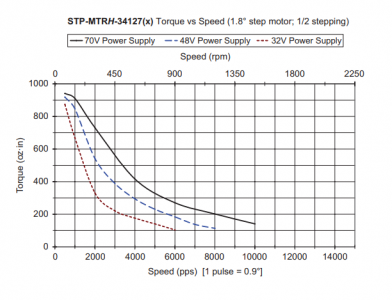- Joined
- Aug 13, 2020
- Messages
- 1,342
For my Bridgeport Boss update, I've decided to go with closed loop stepper motors driven by LinuxCNC running on a Raspberry Pi. I have a Centroid Acorn kit, but I don't like Windows, I don't want computer box in the shop, and I don't want to be tied to software from a company that will disappear in five years. So, open-source for the win. I can make somebody a good deal on an Acorn kit, though.
So, while I'm getting the Pi set up, time to choose the steppers. Not sure what all the criteria for selection should be, though.
Cost isn't an issue. Everything in the general area of the correct size seems to be around $80 (+-$20) for the motor and driver. So that frees us up to look at specs.
Holding torque is primary, of course. The steppers that Bridgeport shipped (and are still on there) are around 600oz-in as far as I can tell. For $90, you can get 1700oz-in.
 www.omc-stepperonline.com
www.omc-stepperonline.com
While the holding torque is specified, I can find no mention of continuous or running torque. Can it be assumed that cont. scales with holding torque? A higher holding torque automatically implies a higher running torque?
Next on the list is form factor. I don't think any modern stepper is a large as the soccer ball sized motors that the BP shipped with. But, Nema 34 seems to be sufficient, with torques up to 1700oz-in. I have to build an adapter to match the existing mounts, so form factor, shaft size, key size, etc. . . don't matter much really.
Boil it all down, and I'm looking for a motor that has a massively larger holding torque than the ones that BP shipped the mill with. Seems simple. Or, am I just being simple?
So, while I'm getting the Pi set up, time to choose the steppers. Not sure what all the criteria for selection should be, though.
Cost isn't an issue. Everything in the general area of the correct size seems to be around $80 (+-$20) for the motor and driver. So that frees us up to look at specs.
Holding torque is primary, of course. The steppers that Bridgeport shipped (and are still on there) are around 600oz-in as far as I can tell. For $90, you can get 1700oz-in.
TS Series 12.0 Nm/1699.68oz.in 1 Axis Closed Loop Stepper CNC Kit Nema 34 Motor & Driver w/ 2m Cable - 1-CL86T-S120|STEPPERONLINE
TS Series 12.0 Nm/1699.68oz.in 1 Axis Closed Loop Stepper CNC Kit Nema 34 Motor & Driver w/ 2m Cable - 1-CL86T-S120 - Closed Loop Stepper Kit - Items in Kit 1 x 34HS59-6004D-E1000: 12.0Nm Closed loop stepper motor 1 x CL86T: Nema 34 Closed loop steppe
 www.omc-stepperonline.com
www.omc-stepperonline.com
While the holding torque is specified, I can find no mention of continuous or running torque. Can it be assumed that cont. scales with holding torque? A higher holding torque automatically implies a higher running torque?
Next on the list is form factor. I don't think any modern stepper is a large as the soccer ball sized motors that the BP shipped with. But, Nema 34 seems to be sufficient, with torques up to 1700oz-in. I have to build an adapter to match the existing mounts, so form factor, shaft size, key size, etc. . . don't matter much really.
Boil it all down, and I'm looking for a motor that has a massively larger holding torque than the ones that BP shipped the mill with. Seems simple. Or, am I just being simple?


